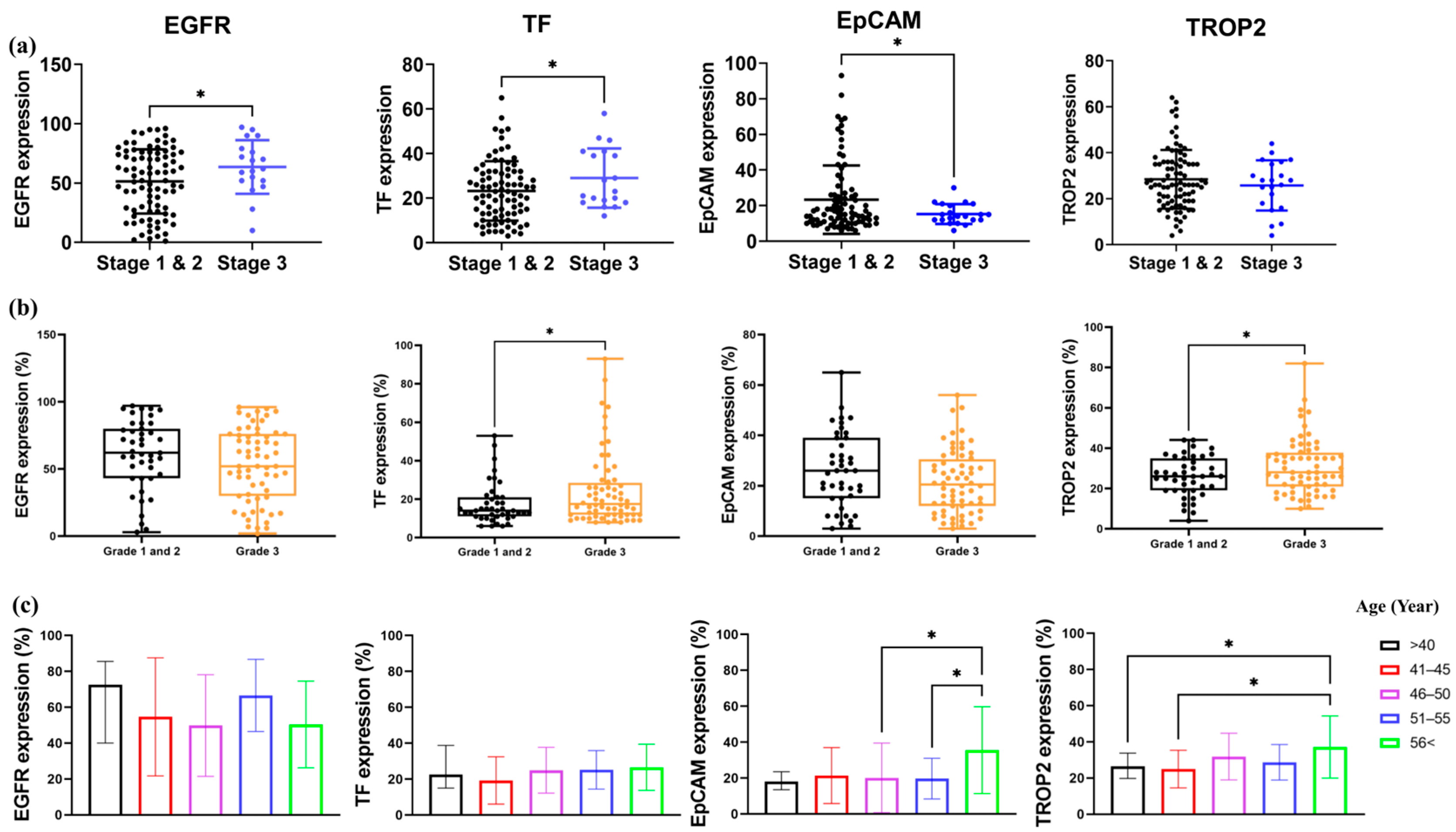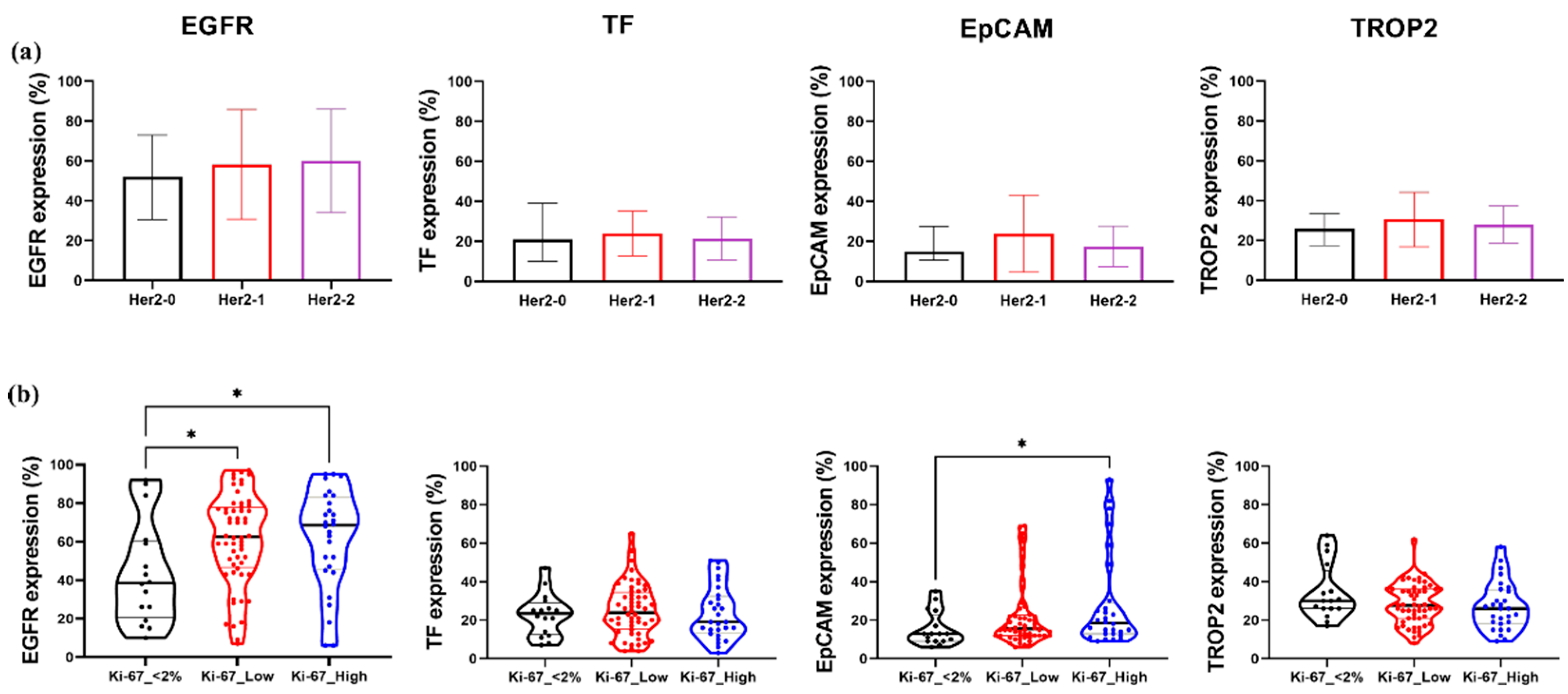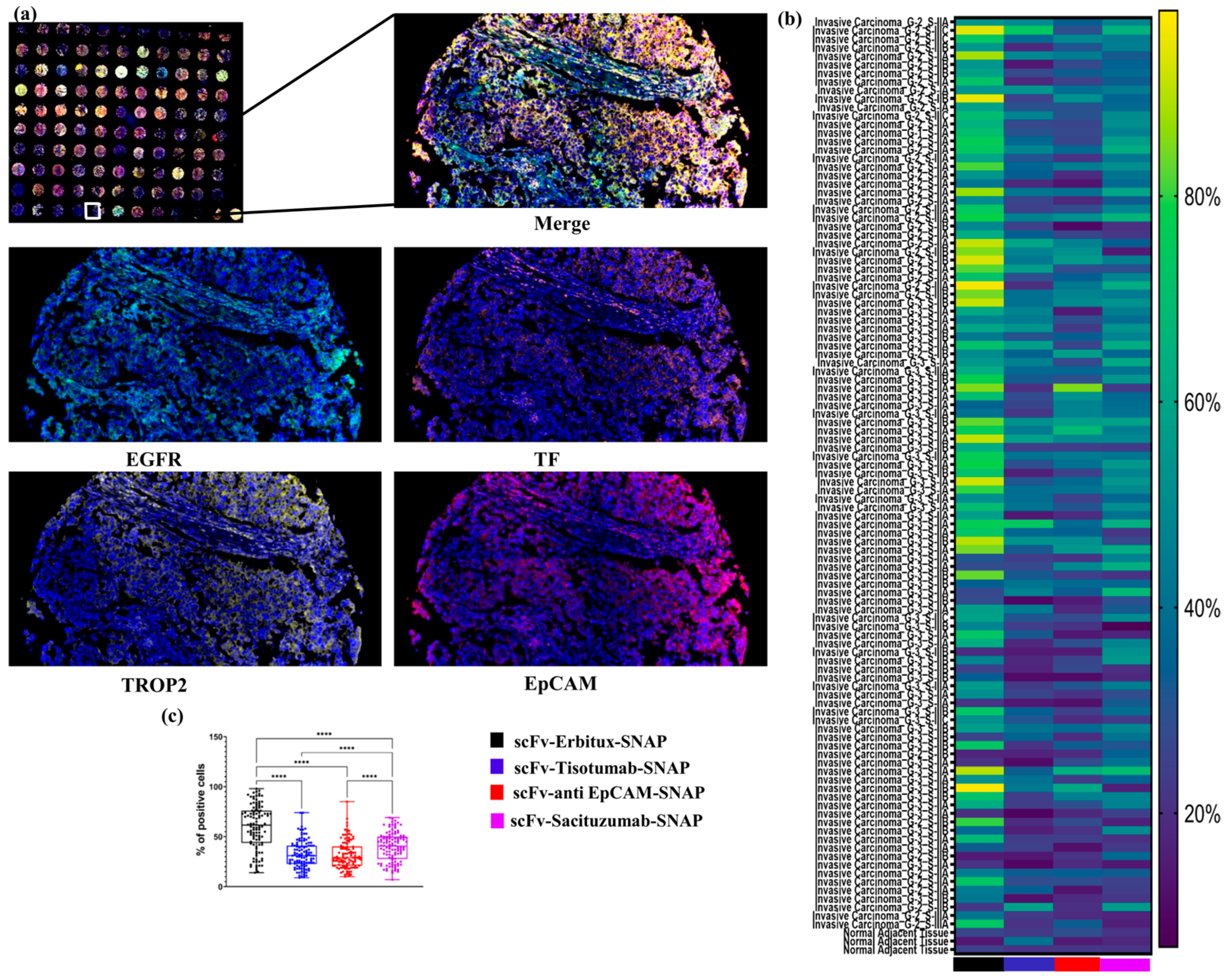Multiplex Immunofluorescence Reveals Therapeutic Targets EGFR, EpCAM, Tissue Factor, and TROP2 in Triple-Negative Breast Cancer
Abstract
1. Introduction
2. Results
2.1. Patient and Tumor Characteristics
2.2. Evaluating the Expression Pattern of EGFR, EpCAM, TF, and TROP2 in TNBC
2.3. Correlation of the EGFR, EpCAM, TF, and TROP2 Expressionsw in TNBC
2.4. Differential Expression Pattern of EGFR, EpCAM, TF, and TROP2 by Tumor Stage, Grade, and Patient Age in TNBC
2.5. EGFR and EpCAM Expression Correlate with Proliferative Index but Not HER2 Status in TNBC
2.6. Evaluating the Binding Specificity scFv-SNAP Fusion Proteins in TNBC Tissue
3. Discussion
4. Materials and Methods
4.1. Tissue Microarray
4.2. Expression Analysis Using mIF
4.3. Cell Culture Conditions
4.4. Recombinant Protein Expression and Protein Enrichment
4.5. Binding Analysis Using mIF
4.6. Statistical Analysis
5. Conclusions
Author Contributions
Funding
Institutional Review Board Statement
Informed Consent Statement
Data Availability Statement
Conflicts of Interest
References
- Kim, J.; Harper, A.; McCormack, V.; Sung, H.; Houssami, N.; Morgan, E.; Mutebi, M.; Garvey, G.; Soerjomataram, I.; Fidler-Benaoudia, M.M. Global patterns and trends in breast cancer incidence and mortality across 185 countries. Nat. Med. 2025, 31, 1154–1162. [Google Scholar] [CrossRef]
- Zagami, P.; Carey, L.A. Triple negative breast cancer: Pitfalls and progress. NPJ Breast Cancer 2022, 8, 95. [Google Scholar] [CrossRef]
- Carvalho, F.M. Targeting low-risk triple-negative breast cancer: A review on de-escalation strategies for a new era. Transl. Breast Cancer Res 2025, 6, 4. [Google Scholar] [CrossRef]
- Chen, Z.; Liu, Y.; Lyu, M.; Chan, C.H.; Sun, M.; Yang, X.; Qiao, S.; Chen, Z.; Yu, S.; Ren, M.J.C.; et al. Classifications of triple-negative breast cancer: Insights and current therapeutic approaches. Cell Biosci. 2025, 15, 13. [Google Scholar] [CrossRef]
- Obidiro, O.; Battogtokh, G.; Akala, E.O. Triple Negative Breast Cancer Treatment Options and Limitations: Future Outlook. Pharmaceutics 2023, 15, 1796. [Google Scholar] [CrossRef]
- Yin, L.; Duan, J.J.; Bian, X.W.; Yu, S.C. Triple-negative breast cancer molecular subtyping and treatment progress. Breast Cancer Res. 2020, 22, 61. [Google Scholar] [CrossRef]
- Barchiesi, G.; Roberto, M.; Verrico, M.; Vici, P.; Tomao, S.; Tomao, F. Emerging Role of PARP Inhibitors in Metastatic Triple Negative Breast Cancer. Current Scenario and Future Perspectives. Front. Oncol. 2021, 11, 769280. [Google Scholar] [CrossRef]
- Litton, J.K.; Rugo, H.S.; Ettl, J.; Hurvitz, S.A.; Gonçalves, A.; Lee, K.H.; Fehrenbacher, L.; Yerushalmi, R.; Mina, L.A.; Martin, M.; et al. Talazoparib in Patients with Advanced Breast Cancer and a Germline BRCA Mutation. N. Engl. J. Med. 2018, 379, 753–763. [Google Scholar] [CrossRef]
- Robson, M.; Im, S.A.; Senkus, E.; Xu, B.; Domchek, S.M.; Masuda, N.; Delaloge, S.; Li, W.; Tung, N.; Armstrong, A.; et al. Olaparib for Metastatic Breast Cancer in Patients with a Germline BRCA Mutation. N. Engl. J. Med. 2017, 377, 523–533. [Google Scholar] [CrossRef]
- Ren, Z.; Xue, Y.; Liu, L.; Zhang, X.; Pei, J.; Zhang, Y.; Wang, Y.; Yu, K. Tissue factor overexpression in triple-negative breast cancer promotes immune evasion by impeding T-cell infiltration and effector function. Cancer Lett. 2023, 565, 216221. [Google Scholar] [CrossRef]
- Jacot, W.; Chateau, M.C.; Thezenas, S.; Guiu, S.; Firmin, N.; Lafont, V.; Lazennec, G.; Theillet, C.; Boissière-Michot, F. Prognostic Value of Trop-2 Expression in Nonmetastatic Triple-Negative Breast Cancer and Correlation With Emerging Biomarkers. Cancer Med. 2025, 14, e70615. [Google Scholar] [CrossRef] [PubMed]
- Liu, D.; He, J.; Yuan, Z.; Wang, S.; Peng, R.; Shi, Y.; Teng, X.; Qin, T. EGFR expression correlates with decreased disease-free survival in triple-negative breast cancer: A retrospective analysis based on a tissue microarray. Med. Oncol. 2012, 29, 401–405. [Google Scholar] [CrossRef] [PubMed]
- Jenkins, S.V.; Nima, Z.A.; Vang, K.B.; Kannarpady, G.; Nedosekin, D.A.; Zharov, V.P.; Griffin, R.J.; Biris, A.S.; Dings, R.P.M. Triple-negative breast cancer targeting and killing by EpCAM-directed, plasmonically active nanodrug systems. NPJ Precis. Oncol. 2017, 1, 27. [Google Scholar] [CrossRef]
- Park, H.S.; Jang, M.H.; Kim, E.J.; Kim, H.J.; Lee, H.J.; Kim, Y.J.; Kim, J.H.; Kang, E.; Kim, S.W.; Kim, I.A.; et al. High EGFR gene copy number predicts poor outcome in triple-negative breast cancer. Mod. Pathol. 2014, 27, 1212–1222. [Google Scholar] [CrossRef]
- Gires, O.; Pan, M.; Schinke, H.; Canis, M.; Baeuerle, P.A. Expression and function of epithelial cell adhesion molecule EpCAM: Where are we after 40 years? Cancer Metastasis Rev. 2020, 3, 969–987. [Google Scholar] [CrossRef]
- Zhang, C.; Sheng, W.; Al-Rawe, M.; Mohiuddin, T.M.; Niebert, M.; Zeppernick, F.; Meihold-Heerlein, I.; Hussain, A.F. EpCAM- and EGFR-Specific Antibody Drug Conjugates for Triple-Negative Breast Cancer Treatment. Int. J. Mol. Sci. 2022, 23, 6122. [Google Scholar] [CrossRef]
- Schmidt, M.; Hasenclever, D.; Schaeffer, M.; Boehm, D.; Cotarelo, C.; Steiner, E.; Lebrecht, A.; Siggelkow, W.; Weikel, W.; Schiffer-Petry, I.; et al. Prognostic effect of epithelial cell adhesion molecule overexpression in untreated node-negative breast cancer. Clin. Cancer Res. 2008, 14, 5849–5855. [Google Scholar] [CrossRef]
- Hu, Z.; Shen, R.; Campbell, A.; McMichael, E.; Yu, L.; Ramaswamy, B.; London, C.A.; Xu, T.; Carson, W.E., 3rd. Targeting Tissue Factor for Immunotherapy of Triple-Negative Breast Cancer Using a Second-Generation ICON. Cancer Immunol. Res. 2018, 6, 671–684. [Google Scholar] [CrossRef]
- Zhang, X.; Li, Q.; Zhao, H.; Ma, L.; Meng, T.; Qian, J.; Jin, R.; Shen, J.; Yu, K. Pathological expression of tissue factor confers promising antitumor response to a novel therapeutic antibody SC1 in triple negative breast cancer and pancreatic adenocarcinoma. Oncotarget 2017, 8, 59086–59102. [Google Scholar] [CrossRef] [PubMed]
- Liu, Y.; Mueller, B.M. Protease-activated receptor-2 regulates vascular endothelial growth factor expression in MDA-MB-231 cells via MAPK pathways. Biochem. Biophys. Res. Commun. 2006, 344, 1263–1270. [Google Scholar] [CrossRef]
- Kasthuri, R.S.; Taubman, M.B.; Mackman, N. Role of tissue factor in cancer. J. Clin. Oncol. 2009, 27, 4834–4838. [Google Scholar] [CrossRef]
- Cole, M.; Bromberg, M. Tissue factor as a novel target for treatment of breast cancer. Oncologist 2013, 18, 14–18. [Google Scholar] [CrossRef][Green Version]
- Cubas, R.; Zhang, S.; Li, M.; Chen, C.; Yao, Q. Trop2 expression contributes to tumor pathogenesis by activating the ERK MAPK pathway. Mol. Cancer 2010, 9, 253. [Google Scholar] [CrossRef]
- Rossi, V.; Turati, A.; Rosato, A.; Carpanese, D. Sacituzumab govitecan in triple-negative breast cancer: From bench to bedside, and back. Front Immunol. 2024, 15, 1447280. [Google Scholar] [CrossRef] [PubMed]
- Liao, Q.; Zhang, R.; Ou, Z.; Ye, Y.; Zeng, Q.; Wang, Y.; Wang, A.; Chen, T.; Chai, C.; Guo, B. TROP2 is highly expressed in triple-negative breast cancer CTCs and is a potential marker for epithelial mesenchymal CTCs. Mol. Ther. Oncol. 2024, 32, 200762. [Google Scholar] [CrossRef]
- Voduc, D.; Kenney, C.; Nielsen, T.O. Tissue microarrays in clinical oncology. Semin. Radiat. Oncol. 2008, 18, 89–97. [Google Scholar] [CrossRef] [PubMed]
- Iesmantas, T.; Paulauskaite-Taraseviciene, A.; Sutiene, K. Enhancing multi-tissue and multi-scale cell nuclei segmentation with deep metric learning. Appl. Sci. 2020, 10, 615. [Google Scholar] [CrossRef]
- Sheng, W.; Zhang, C.; Mohiuddin, T.M.; Al-Rawe, M.; Zeppernick, F.; Falcone, F.H.; Meinhold-Heerlein, I.; Hussain, A.F. Multiplex Immunofluorescence: A Powerful Tool in Cancer Immunotherapy. Int. J. Mol. Sci. 2023, 24, 3086. [Google Scholar] [CrossRef] [PubMed]
- Bianchini, G.; Balko, J.M.; Mayer, I.A.; Sanders, M.E.; Gianni, L. Triple-negative breast cancer: Challenges and opportunities of a heterogeneous disease. Nat. Rev. Clin. Oncol. 2016, 13, 674–690. [Google Scholar] [CrossRef]
- Varzaru, V.B.; Vlad, T.; Popescu, R.; Vlad, C.S.; Moatar, A.E.; Cobec, I.M. Triple-Negative Breast Cancer: Molecular Particularities Still a Challenge. Diagnostics 2024, 14, 1875. [Google Scholar] [CrossRef]
- Zhang, C.; Sheng, W.; Mohiuddin, T.M.; Al-Rawe, M.; Schmitz, R.; Niebert, M.; Zeppernick, F.; Meihold-Heerlein, I.; Hussain, A.F. A coiled coil-based pre-targeting drug delivery system for precise treatment of breast cancer. Eur. J. Pharm. Biopharm. 2025, 214, 114794. [Google Scholar] [CrossRef] [PubMed]
- Ehrenberg, A.J.; Morales, D.O.; Piergies, A.M.H.; Li, S.H.; Tejedor, J.S.; Mladinov, M.; Mulder, J.; Grinberg, L.T. A manual multiplex immunofluorescence method for investigating neurodegenerative diseases. J. Neurosci. Methods 2020, 339, 108708. [Google Scholar] [CrossRef]
- Lin, Y.; Singh, S.; Xu, C.; Wang, Z.; Feng, C.; Jiang, D.; Luo, L.; Li, W.; Che, W.; Zhu, G. Protocol for tyramide signal amplification immunohistochemical detection of Notch1 signaling in the vascular system. STAR Protoc. 2024, 5, 103519. [Google Scholar] [CrossRef]
- Sachdeva, A.; Hart, C.A.; Carey, C.D.; Vincent, A.E.; Greaves, L.C.; Heer, R.; Oliveira, P.; Brown, M.D.; Clarke, N.W.; Turnbull, D.M. Automated quantitative high-throughput multiplex immunofluorescence pipeline to evaluate OXPHOS defects in formalin-fixed human prostate tissue. Sci. Rep. 2022, 12, 6660. [Google Scholar] [CrossRef]
- Changavi, A.A.; Shashikala, A.; Ramji, A.S. Epidermal Growth Factor Receptor Expression in Triple Negative and Nontriple Negative Breast Carcinomas. J. Lab. Physicians 2015, 7, 79–83. [Google Scholar] [CrossRef]
- Viale, G.; Rotmensz, N.; Maisonneuve, P.; Bottiglieri, L.; Montagna, E.; Luini, A.; Veronesi, P.; Intra, M.; Torrisi, R.; Cardillo, A.; et al. Invasive ductal carcinoma of the breast with the “triple-negative” phenotype: Prognostic implications of EGFR immunoreactivity. Breast Cancer Res. Treat. 2009, 116, 317–328. [Google Scholar] [CrossRef]
- Jeon, Y.; Jo, U.; Hong, J.; Gong, G.; Lee, H.J. Trophoblast cell-surface antigen 2 (TROP2) expression in triple-negative breast cancer. BMC Cancer 2022, 22, 1014. [Google Scholar] [CrossRef]
- Soysal, S.D.; Muenst, S.; Barbie, T.; Fleming, T.; Gao, F.; Spizzo, G.; Oertli, D.; Viehl, C.T.; Obermann, E.C.; Gillanders, W.E. EpCAM expression varies significantly and is differentially associated with prognosis in the luminal B HER2(+), basal-like, and HER2 intrinsic subtypes of breast cancer. Br. J. Cancer 2013, 108, 1480–1487. [Google Scholar] [CrossRef] [PubMed]
- de Bono, J.S.; Harris, J.R.; Burm, S.M.; Vanderstichele, A.; Houtkamp, M.A.; Aarass, S.; Riisnaes, R.; Figueiredo, I.; Nava Rodrigues, D.; Christova, R.; et al. Systematic study of tissue factor expression in solid tumors. Cancer Rep. 2023, 6, e1699. [Google Scholar] [CrossRef] [PubMed]
- Wee, P.; Wang, Z. Epidermal Growth Factor Receptor Cell Proliferation Signaling Pathways. Cancers 2017, 9, 52. [Google Scholar] [CrossRef]
- Milsom, C.C.; Yu, J.L.; Mackman, N.; Micallef, J.; Anderson, G.M.; Guha, A.; Rak, J.W. Tissue factor regulation by epidermal growth factor receptor and epithelial-to-mesenchymal transitions: Effect on tumor initiation and angiogenesis. Cancer Res. 2008, 68, 10068–10076. [Google Scholar] [CrossRef]
- Zheng, J.; Zhao, L.; Wang, Y.; Zhao, S.; Cui, M. Clinicopathology of EpCAM and EGFR in Human Epithelial Ovarian Carcinoma. Open Med. 2017, 12, 39–44. [Google Scholar] [CrossRef]
- Lenárt, S.; Lenárt, P.; Šmarda, J.; Remšík, J.; Souček, K.; Beneš, P. Trop2: Jack of All Trades, Master of None. Cancers 2020, 12, 3328. [Google Scholar] [CrossRef]
- Unruh, D.; Horbinski, C. Beyond thrombosis: The impact of tissue factor signaling in cancer. J. Hematol. Oncol. 2020, 13, 93. [Google Scholar] [CrossRef] [PubMed]
- Dum, D.; Hube-Magg, C.; Simon, R.; Bady, E.; Mandelkow, T.; Blessin, N.; Lennartz, M.; Sauter, G.; Minner, S.; Luebke, A. 83P Patterns of trophoblast cell surface antigen 2 (TROP2) and epithelial cell adhesion molecule (EPCAM) expression in human tumors: A tissue microarray study on 14,766 tumors. Ann. Oncol. 2022, 33, S578. [Google Scholar] [CrossRef]
- Nafissi, N.; Azad Armaki, S.; Babaee, E.; Babaheidarian, P.; Safari, E.; Sayad, S.; Saghafinia, S.; Safaee, M. Association between EPCAM upregulation and clinicopathological parameters and outcomes of breast cancer. Int. J. Clin. Exp. Pathol. 2024, 17, 421–428. [Google Scholar] [CrossRef] [PubMed]
- Inamura, K.; Yokouchi, Y.; Kobayashi, M.; Ninomiya, H.; Sakakibara, R.; Subat, S.; Nagano, H.; Nomura, K.; Okumura, S.; Shibutani, T.; et al. Association of tumor TROP2 expression with prognosis varies among lung cancer subtypes. Oncotarget 2017, 8, 28725–28735. [Google Scholar] [CrossRef]
- Regina, S.; Rollin, J.; Bléchet, C.; Iochmann, S.; Reverdiau, P.; Gruel, Y. Tissue factor expression in non-small cell lung cancer: Relationship with vascular endothelial growth factor expression, microvascular density, and K-ras mutation. J. Thorac. Oncol. 2008, 3, 689–697. [Google Scholar] [CrossRef]
- Hemida, A.S.; Taie, D.M.; El-Wahed, M.M.A.; Shabaan, M.I.; Tantawy, M.S.; Ehsan, N.A. EpCAM, Ki67, and ESM1 Predict Hepatocellular Carcinoma Recurrence After Liver Transplantation. Appl. Appl. Immunohistochem. Mol. Morphol. 2023, 31, 596–606. [Google Scholar] [CrossRef]
- Kroepil, F.; Dulian, A.; Vallböhmer, D.; Geddert, H.; Krieg, A.; Vay, C.; Topp, S.A.; am Esch, J.S.; Baldus, S.E.; Gires, O.; et al. High EpCAM expression is linked to proliferation and lauren classification in gastric cancer. BMC Res. Notes 2013, 6, 253. [Google Scholar] [CrossRef]
- Bankhead, P.; Loughrey, M.B.; Fernández, J.A.; Dombrowski, Y.; McArt, D.G.; Dunne, P.D.; McQuaid, S.; Gray, R.T.; Murray, L.J.; Coleman, H.G.; et al. QuPath: Open source software for digital pathology image analysis. Sci. Rep. 2017, 7, 16878. [Google Scholar] [CrossRef] [PubMed]
- Hussain, A.F.; Heppenstall, P.A.; Kampmeier, F.; Meinhold-Heerlein, I.; Barth, S. One-step site-specific antibody fragment auto-conjugation using SNAP-tag technology. Nat. Protoc. 2019, 14, 3101–3125. [Google Scholar] [CrossRef] [PubMed]
- Stöcker, M.; Tur, M.K.; Sasse, S.; Krüssmann, A.; Barth, S.; Engert, A. Secretion of functional anti-CD30-angiogenin immunotoxins into the supernatant of transfected 293T-cells. Protein Expr. Purif. 2003, 28, 211–219. [Google Scholar] [CrossRef] [PubMed]





| Characteristics | Values | |
|---|---|---|
| Sex | Female | 110 |
| Age | Median | 48 |
| Range | 27–86 | |
| Stages | Stage I | 6 |
| Stage II | 80 | |
| Stage III | 21 | |
| Grades | Grade 1 | 1 |
| Grade 2 | 42 | |
| Grade 3 | 64 | |
| Malignant invasive carcinoma | 107 | |
| Her2 status | Her2-0 | 39 |
| Her2-1 | 46 | |
| Her2-2 | 21 | |
| Her2-3 | 3 | |
| Ki-67 status | <2% | 19 |
| ≤49% | 58 | |
| ≥50% | 33 | |
| ER status | negative | 105 |
| positive | 4 | |
| PR status | negative | 106 |
| positive | 3 | |
Disclaimer/Publisher’s Note: The statements, opinions and data contained in all publications are solely those of the individual author(s) and contributor(s) and not of MDPI and/or the editor(s). MDPI and/or the editor(s) disclaim responsibility for any injury to people or property resulting from any ideas, methods, instructions or products referred to in the content. |
© 2025 by the authors. Licensee MDPI, Basel, Switzerland. This article is an open access article distributed under the terms and conditions of the Creative Commons Attribution (CC BY) license (https://creativecommons.org/licenses/by/4.0/).
Share and Cite
Mohiuddin, T.M.; Sheng, W.; Zhang, C.; Al-Rawe, M.; Tchaikovski, S.; Zeppernick, F.; Meinhold-Heerlein, I.; Hussain, A.F. Multiplex Immunofluorescence Reveals Therapeutic Targets EGFR, EpCAM, Tissue Factor, and TROP2 in Triple-Negative Breast Cancer. Int. J. Mol. Sci. 2025, 26, 7430. https://doi.org/10.3390/ijms26157430
Mohiuddin TM, Sheng W, Zhang C, Al-Rawe M, Tchaikovski S, Zeppernick F, Meinhold-Heerlein I, Hussain AF. Multiplex Immunofluorescence Reveals Therapeutic Targets EGFR, EpCAM, Tissue Factor, and TROP2 in Triple-Negative Breast Cancer. International Journal of Molecular Sciences. 2025; 26(15):7430. https://doi.org/10.3390/ijms26157430
Chicago/Turabian StyleMohiuddin, T. M., Wenjie Sheng, Chaoyu Zhang, Marwah Al-Rawe, Svetlana Tchaikovski, Felix Zeppernick, Ivo Meinhold-Heerlein, and Ahmad Fawzi Hussain. 2025. "Multiplex Immunofluorescence Reveals Therapeutic Targets EGFR, EpCAM, Tissue Factor, and TROP2 in Triple-Negative Breast Cancer" International Journal of Molecular Sciences 26, no. 15: 7430. https://doi.org/10.3390/ijms26157430
APA StyleMohiuddin, T. M., Sheng, W., Zhang, C., Al-Rawe, M., Tchaikovski, S., Zeppernick, F., Meinhold-Heerlein, I., & Hussain, A. F. (2025). Multiplex Immunofluorescence Reveals Therapeutic Targets EGFR, EpCAM, Tissue Factor, and TROP2 in Triple-Negative Breast Cancer. International Journal of Molecular Sciences, 26(15), 7430. https://doi.org/10.3390/ijms26157430







